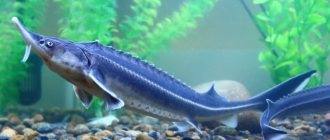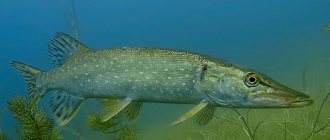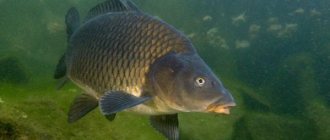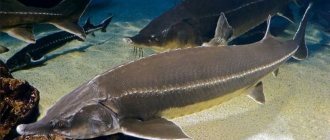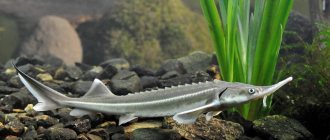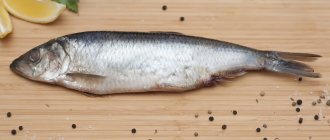Mackerel fish
You will learn the answer to the question of where mackerel is found in this article. It belongs to the order Perciformes and is part of the mackerel family. Interestingly, its cycle is not at all connected with the bottom, so it is considered a pelagic fish.
This is a fairly large fish. Its length can reach 64 centimeters. Average individuals are about 30 centimeters. The body is shaped like a spindle, which is covered with small scales. It is noteworthy that the swim bladder, which is obligatory for many species of fish, may or may not be present in mackerel.
Description
Mackerel is a fish of the mackerel family, perch-like order.
This family is very extensive and includes more than 50 species of fish.
But we will talk about the subspecies that is closest and most familiar to us - the Atlantic mackerel, or mackerel.
This fish is familiar to both fishermen and housewives, as it is one of the most popular commercial fish.
The mackerel's body is elongated, spindle-shaped, with very smooth, streamlined outlines. The length of the body is from 30 to 60 cm. In the Atlantic Ocean it is capable of gaining weight up to 1.5 kilograms. But more often there are individuals weighing 300-400 grams.
The color is metallic gray on the sides, sometimes with a blue tint. The back is dark green to graphite with many dark curved wide stripes.
The abdomen is light, almost white. Along the body there is a dim gray stripe. The scales are very small. The mackerel's head is triangular and elongated.
The mouth is located at eye level, slightly slanted. The eyes are round, medium in size, color - from golden yellow to dark brown.
A notable feature of the Atlantic mackerel is its lack of a swim bladder. Schooling fish. Maximum age is 17-18 years.
The calorie content of fresh mackerel is 191 Kcal per 100 grams of product.
A relative of the perch
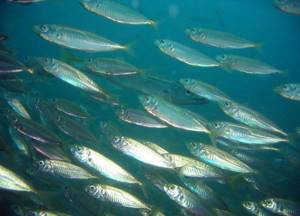
Despite the fact that mackerel is considered a very noble fish, its close relative is perch. And its other name is mackerel. The maximum weight of mackerel can reach two kilograms. But its small specimens can be quite small, weighing approximately 300-350 grams.
The fish that this article is devoted to has a silver body color, its back is bluish-green, and transverse dark stripes run throughout its body. Mackerel has additional fins in addition to the standard pectoral and dorsal fins.
Like most members of the mackerel family, you can see a bony ring located around the eyes. She also has a pointed snout and small conical teeth.
How to cook and serve?
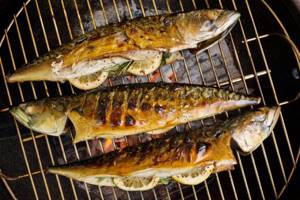
Mackerel is quite remarkable not only for its large list of beneficial properties, but also for the fact that it can be prepared in any of a variety of ways. Cooks stew it, pickle it, stuff it, fry it, smoke it, pickle it, boil it, bake it.
To avoid buying stale mackerel, when purchasing fish, be guided by the following factors:
- Eyes. If the mackerel's eyes are bulging and moist, they are bright and full - the fish is fresh. Otherwise, the eyes look dry and wrinkled.
- Gills. This is practically a litmus test that will help determine the time of death of a fish. Fresh goods have clean, red or pink gills, without mucus or unpleasant odor.
- Aroma. Fresh carcass without a pronounced fishy or rancid odor.
- Appearance. The skin should look moisturized, elastic and shiny, without any extraneous spots or holes. The opposite appearance indicates that the fish is expired.
- Elasticity. High-quality fish have meat that is not loose, lumpy or plastic. Fresh mackerel has a flat belly, while stale mackerel has a swollen belly.
Store fresh, ungutted mackerel in the refrigerator; the period of such storage should not exceed 1 day. If the fish is cleaned, this will increase storage to 3 days.
The shelf life of mackerel in crushed ice increases to 10-14 days. Fresh mackerel fish can be stored in the freezer for 2-3 months, but keep in mind that after defrosting, the fish meat will be loose.
Video
Habitat
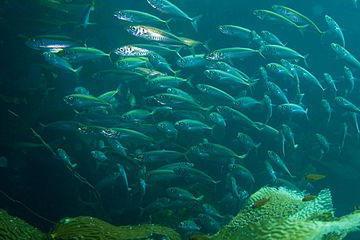
So, where is mackerel found? Mostly it prefers to live in the oceans and is more or less distributed throughout all parts of the world. It is absent only in one ocean on planet Earth - the Arctic Ocean.
Where mackerel swim, as a rule, large-scale expeditions are organized to catch it. From the oceans, fish swim into all kinds of seas adjacent to them. So, everyone who is interested in its fishing knows where the mackerel fish is found. For example, there is a lot of it in the waters of the White Sea. She also swims into all sorts of inland seas. These are Marble, Baltic, Black and many others. Now you know exactly where mackerel is found.
It is found all over the planet and even reaches the shores of North America. It matters where the mackerel live during their summer migration. Schools of this fish enter the White and Barents Seas. A lot of it is collected near the Irish coast, especially in the southwest of the country.
As you can see, this is a very common species. Therefore, to answer the question of where mackerel lives in Russia, it is enough to list most of the seas in which there are Russian territorial waters. By the way, Atlantic or Far Eastern mackerel most often ends up on the shelves of domestic stores.
From this article you learned where mackerel is found in Russia.
Little tricks for catching
Mackerel has always been considered a very valuable fish, so mankind has always hunted this fish at all times. The habitat of this predator is very large. And this makes it possible to catch it in almost all the seas and oceans that exist on the planet.
During the summer months, large schools of mackerel can be found along the coast of the Pacific and Atlantic oceans. In the area of Novaya Zemlya and the Murmansk coast, fishermen become more active at this time. And also in the waters of the White and Marmara seas there is activity of fishing vessels whose fishery is mackerel. To catch this predator, all kinds of nets, trawls, and hooks are used.
Amateur fishermen often go out to hunt this predator. Fishing for mackerel at this time does not require much cunning or invention. For good and productive fishing, it is better to use a small yacht. In extreme cases, an ordinary boat will do. The predator is very greedy at this time of year and is easy to catch with all kinds of shiny bait. The main condition for good fishing is that the bait in the water is visible from afar. Then the catch will be good. For bait most often used:
- Small fish;
- Meat of crabs, mules and squids;
- All kinds of artificial colorful baits.
For a good catch with artificial baits, various flavorings are often used, which are now available in large quantities on the shelves of fishing stores. But still, we must admit that the most productive fishing will be with live bait. After all, the hunt is for a sea predator. All sea and river predators respond better to bait that is included in their diet.
Lifestyle
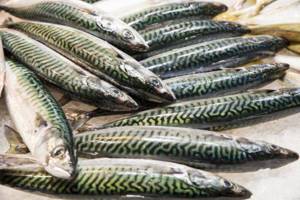
Where mackerel lives, the catch is usually good, because it prefers to swim not along the bottom, but close to the surface of the water. These are excellent swimmers that are adapted to life in salt waters.
A large number of additional fins helps them avoid getting caught in whirlpools when moving rapidly. The fish always stay in schools, often teaming up with Peruvian sardines. Mackerel has many enemies both in the water and in the air. These include pelicans, dolphins, sharks, sea lions, and even large tuna.
Mackerel feels comfortable only at temperatures from 8 to 20 degrees. So she has to migrate. All year round she lives only in the fairly warm waters of the Indian Ocean.
At the same time, even in Turkish waters they are not warm enough, so as soon as the temperature drops, the mackerel swims away to their native places. From the Black Sea, fish move closer to the north of Europe. There are often warm currents that provide them with a comfortable existence. During periods of migration, mackerel are inactive, spending strength and energy exclusively on searching for food.
In water it can reach high speeds - up to 30 km/h.
Fishing methods
Atlantic mackerel is very popular as an object of industrial fishing.
It is hunted by small fishing cooperatives and huge food corporations. And this is not surprising.
After all, mackerel has valuable nutritional qualities - its meat is rich in vitamin B12 and a unique set of fats and amino acids.
Although, due to the specific smell and taste, many housewives prefer mackerel in ready-made form - smoked or in the form of canned food.
During the mackerel migrations off the coast of Norway, amateur fishermen catch it literally with whatever they have - after all, the fish stay in large schools almost at the very surface of the water.
The gear must be powerful and strong, since mackerel, despite its size, is very lively and fast.
Spinning rod up to 3 m with a powerful reel (multiplier), and both purchased and homemade spinners are suitable as bait. Also very popular is a tackle called “Tyrant”.
And at the end of the article there is a video: fishing for mackerel.
Source: blogribaka.ru
How does mackerel eat?
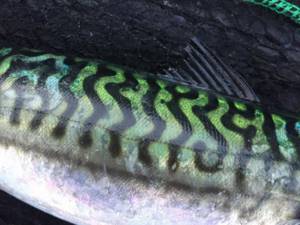
Mackerel are classic predators. They eat plankton and small crustaceans that are filtered out of the water. Adult fish can eat squid or small fish.
When attacking its prey, the mackerel makes a throw, reaching a speed of up to 80 km/h in a matter of seconds. During the hunt, mackerel gather in schools. Often attacks anchovy, sandfish, and sprats.
Acting in a school, mackerel forces its prey to rise to the surface. Essentially drives opponents into a corner. And then he starts eating. It is also joined by surrounding predators, such as dolphins or seagulls. Such a gathering of fish is clearly visible from above.
Despite its relatively small size, mackerel is very voracious. The Australian mackerel has the most brutal appetite. She eats everything without really thinking about whether it is edible. This is often used by Australian anglers. Such mackerel can be caught even on a hook without bait.
What can you cook from mackerel?
There are a lot of step-by-step and step-by-step video recipes online for preparing delicious and healthy mackerel dishes, and it is simply impossible to list them. mackerel
- salted and smoked,
- boiled or fried,
- stewed and cooked over an open fire,
- they make planed meat out of it,
- baked in foil and clay,
- stuffed, marinated.
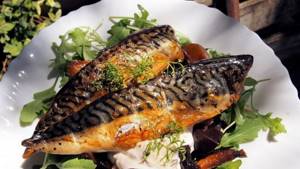
It is very important to properly clean the mackerel before cooking. The carcass must be thoroughly washed and freed from fins and entrails. Particular attention must be paid to removing the black film inside the carcass - micro particles of internal organs may remain on it, which spoils the taste of the fish and “kills” its characteristic aroma.
Mackerel breeding
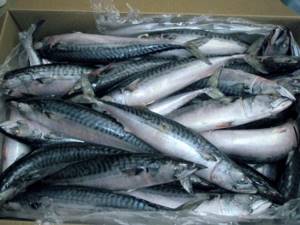
Mackerel begins to spawn in the second year of life. After this, it bears offspring every year. The advanced age of this fish begins at the end of its second decade.
Adult fish spawn in mid-spring, and young fish reproduce at the end of June. Their reproduction occurs very actively, because the fish are very prolific. At one time, she can leave about five hundred thousand eggs at a depth of about two hundred meters. The diameter of each egg is almost invisible to the human eye - it is only about one millimeter. Each of them contains a drop of fat, with the help of which the fry feeds throughout its development.
How long the larvae will form directly depends on how comfortable the conditions exist around. On average, this period ranges from ten days to three weeks. The mackerel larvae themselves are carnivorous, but also very aggressive. At times the thirst for food can awaken in them such that they are able to pounce and eat each other.
The fry that are born are quite small in size. Only a few centimeters long. But by autumn they grow very rapidly. Their size increases at least three times. After this, the growth rate of young mackerel slows down noticeably.

